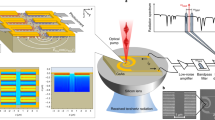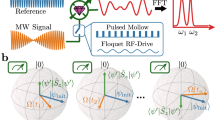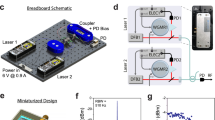Abstract
THE development of the CN maser1 as a continuous wave source of coherent radiation at a wavelength of 0.337 mm has made possible the use of a heterodyne detection system for this wavelength. The advantages of heterodyne detection are well known2. To use this technique a source of coherent radiation and a suitable detector are required. It is a general characteristic of infra-red and sub-millimetre wave detectors that their voltage output is proportional to the radiation power input so that they are equivalent to radio-frequency square law detectors. If a detector of this type is placed in a position at which two beams of radiation of similar wavelength interfere, the detector output will be proportional to (P1 P2)½ where P1 and P2 are the powers received from the first and second beams respectively. If P1 is modulated in some way so that it contains components of frequency ν1 differing slightly from the frequency ν2 of P2, the output from the detector will contain components alternating at the difference frequency (ν1–ν2). If the intensity of the unmodulated beam P2 is greater than that of P1, the output signal will be proportional to (P1 P2)½ and correspondingly greater than the signal which would be obtained if a weak beam P1 only were received by the detector (this assumes, of course, that the relative phases of the two beams at the detector are adjusted for maximum intensity). Thus the difficulty of detecting a weak signal P1 can be reduced by using a heterodyne technique. In some applications the difference frequency (ν1–ν2) may be relatively large, so that for this technique to be of practical value a detector with a wide frequency response is required. On the other hand, in some applications in spectroscopy or radiometry long integration times can be used to facilitate the detection of very weak signals. This is equivalent to a situation in which (ν1–ν2) is very small. In measurements of this type, therefore, the use of detectors with low frequency response can be satisfactory.
This is a preview of subscription content, access via your institution
Access options
Subscribe to this journal
Receive 51 print issues and online access
$199.00 per year
only $3.90 per issue
Buy this article
- Purchase on Springer Link
- Instant access to full article PDF
Prices may be subject to local taxes which are calculated during checkout
Similar content being viewed by others
References
Gebbie, H. A., Stone, N. W. B., Slough, W., Chamberlain, J. E., and Sheraton, W. A., Nature, 211, 62 (1966).
Ross, M., Laser Receivers (John Wiley, 1966).
Putley, E. H., App. Optics, 4, 649 (1965).
Putley, E. H., Proc. I.E.E.E., 54, 1096 (1966).
Grimes, C. C., Richards, P. L., and Shapiro, S., Phys. Rev. Letters, 17, 431 (1966).
Author information
Authors and Affiliations
Rights and permissions
About this article
Cite this article
GEBBIE, H., STONE, N., PUTLEY, E. et al. Heterodyne Detection of Sub-millimetre Radiation. Nature 214, 165–166 (1967). https://doi.org/10.1038/214165a0
Received:
Issue Date:
DOI: https://doi.org/10.1038/214165a0
This article is cited by
-
Detectors for infrared heterodyne mixing and detection
Space Science Reviews (1975)
-
Linear receiver for the submillimeter range
Radiophysics and Quantum Electronics (1969)
-
Interference of Sub-millimetre Waves over 450 m Path Difference
Nature (1968)
Comments
By submitting a comment you agree to abide by our Terms and Community Guidelines. If you find something abusive or that does not comply with our terms or guidelines please flag it as inappropriate.



